

Dr. Amol Saxena, DPM
Palo Alto Foundation
Medical Group
Dept. of Sports Medicine
3rd Floor, Clark Building
795 El Camino Real
Palo Alto, CA 94301
Office: 650-853-2943
Fax: 650-853-6094
E-Mail
Map | Directions

| Injury Prevention |
 Calves
Calves
To stretch your calves, stand facing a support, with one foot at least a foot in front of the other and your hands in front of you pressed against the support. Lean into the support making sure you point your toes straight ahead. Keep your heels flat, put your weight on the front leg, and don't bounce. Straighten the back knee and hold the stretch for 30 seconds, then bend the knee and hold for another 30 seconds. Switch legs and repeat.
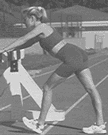 Hamstrings
Hamstrings
Stretching the hamstrings can be tricky, but doing so is extremely helpful for runners. Start in the same position as the calf stretch. Place your weight on the back leg (the one opposite the one you'll be stretching). Keeping the back leg straight, press your back foot into the ground. Bend your front leg slightly and flex your front foot until you feel a stretch in the hamstring. Hold for 30 seconds, then straighten the front knee and hold for another 30 seconds. Switch legs and repeat.
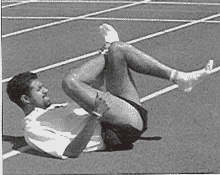 Gluteals
Gluteals
One of the best stretches for the gluteal muscles (the large buttocks muscles) is the pretzel. Lie on your back and bend both knees. Place your right foot over your left knee. Move the left knee toward you, feeling the stretch in your right gluteal muscles. Hold for 30 seconds, seeking a deeper stretch if you can. Switch legs and repeat.
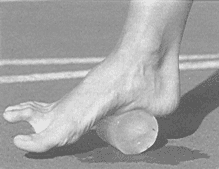 Ice and Heat
Ice and Heat
Icing works as an anti-inflammatory method to reduce the swelling of an injured or overworked area by limiting the blood flow to the area. In general, icing is appropriate for both chronic and acute injuries. The cold shrinks (vasoconstricts) the blood vessels, thus reducing the flow of blood to a body part. This decreases the amount of swelling that can occur.
The ideal way to ice is to put ice cubes in water to create a solution with a temperature of 45 to 50 degrees (7 to 10 degrees Celsius). Put the mixture in a sturdy plastic bag to create an icepack that is malleable for use on various parts of the body. I recommend icing for 10 to 15 minutes, ideally immediately after exercise.
Rolling your foot on a frozen water bottle or a cube of ice formed from a paper cup for five minutes is great for plantar fasciitis (arch and heel pain).
Chemical (blue ice) packs can be dangerous, judging from my experience and the experience of some of my patients. Use them with caution, as I've had several patients unknowingly get mild frostbite because the packs were much colder than the conventional ice pack that I described above.
Heat warms and loosens stiff muscles and joints, facilitating easier movement. It also draws blood, which contains oxygen and nutrients, to an injured area, thus aiding the healing process. Use heat before exercise or during rehab. Heating generally can be initiated when bleeding (bruising and throbbing) has subsided, which is normally at least 72 hours postinjury. Moist heat such as that provided by a Jacuzzi or hot tub is ideal. Make sure the temperature is set at 100 to 105 degrees (38-41 degrees Celsius) and one minute at 50 degrees (10 degrees Celsius), works well for ankle sprains a few days after the injury. The alternating temperatures cause a flushing out, or pumping action, of blood flow. Repeat for three cycles, then leave your ankle in cold water for four to five minutes after the third cycle to "ice down" the injury.
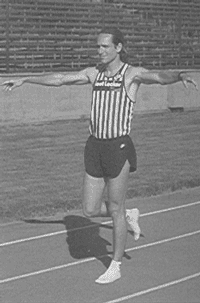 Stork
Stork
This is a great way to regain your balance sense (proprioception) after ankle sprains and to help prevent sprains by building up the stabilizing muscles in the legs. Stand relaxed and raise your arms to the sides. Bend one knee, raising the foot behind you. Try to balance for at least 15 seconds. Waving your arms makes it harder and builds the hip and knee stabilizers.
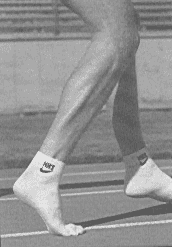 Heel Raises
Heel Raises
These are a great way to build up the inner-calf muscles, which are frequently injured in runners who are experiencing shin pain. Stand with one foot in front of the other, knees slightly bent. Point your toes slightly inward, then rise up on your toes. Hold for a second, then slowly lower. Add to the challenge by doing them one leg at a time, starting with three sets of 20.
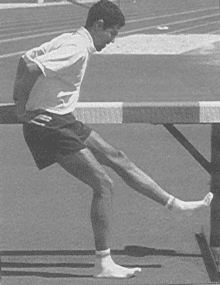 Quarter Squats
Quarter Squats
Do quarter squats one leg sit a time. Stand with your feet about shoulder-width apart, toes pointed forward. Hold on to something for balance, such as the back of a chair or a doorway Extend one leg in front of you and bend the opposite knee, slowly lowering your buttocks about a foot, as if sitting down in a chair. Keep the lower half of your support leg perpendicular to the ground (don't let it go forward) so that you feel your hamstrings and buttocks working. Keep your knee centered over your foot. Hold, then return to start position. Start with two sets of 10 on each side.
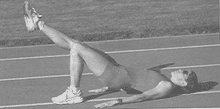 Leg Press-Ups (Bridges)
Leg Press-Ups (Bridges)
These are great for building up your gluteal muscles and hamstrings. Lie on your back, bend one knee, and press the foot into the floor. Extend the other leg up and forward as shown. Press your foot down to elevate your buttocks and lower back. Start with three sets of 10, then switch legs.
Dynamic Stretching with Patient Dathan Ritzenhein
Home | About Dr. Saxena | Articles | Appointments | Shoe List | Orthoses
Medial Distal Tibial Syndrome (Shin Splints) | Sever's Disease/Calcaneal Apophysitis
Ankle Sprains & Calf Strains | Injury Prevention | Heel Pain | Achilles Heel | Ankle Stretching, Rehabilitation & Taping
Return to Sports After Injury | Cycling | Marathons | Videos | Recommended Books | Links
Friends & Patients | Legal Notice | Privacy Statement | Site Map
Copyright © Amol Saxena, DPM - Sports Medicine & Surgery of the Foot & Ankle
Web Site Design, Hosting & Maintenance By Catalyst Marketing Innovations, LLC/ Worry Free Websites



